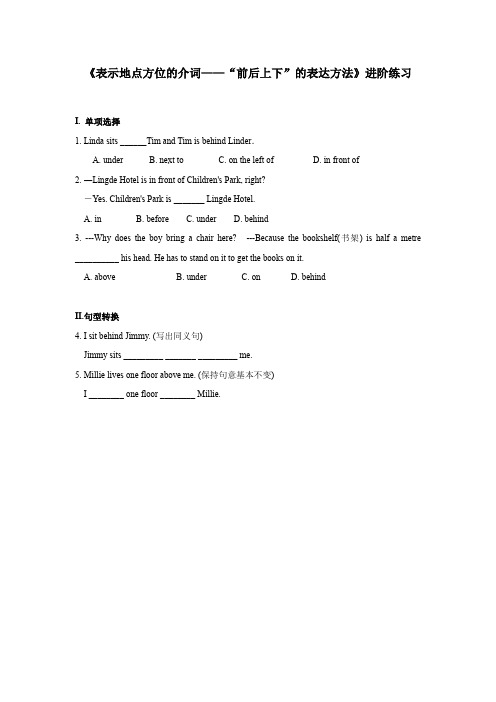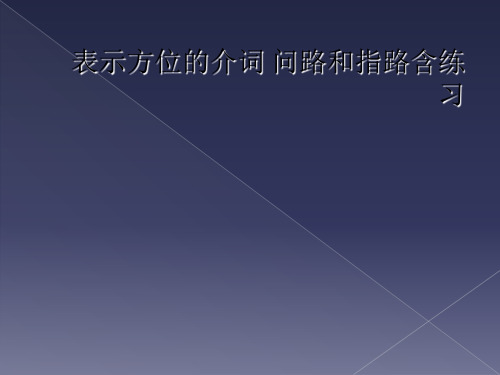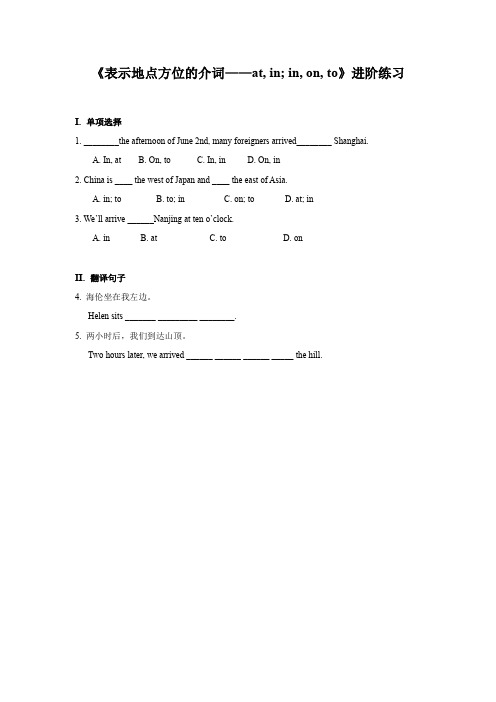《表示地点方位的介词——“前后上下”的表达方法》进阶练习(三) (2)
- 格式:docx
- 大小:15.06 KB
- 文档页数:2

《表示地点方位的介词——“前后上下”的表达方法》进阶练习I. 单项选择1. Linda sits ______Tim and Tim is behind Linder.A. underB. next toC. on the left ofD. in front of2. ―Lingde Hotel is in front of Children's Park, right?―Yes. Children's Park is _______ Lingde Hotel.A. inB. beforeC. underD. behind3. ---Why does the boy bring a chair here? ---Because the bookshelf(书架) is half a metre __________ his head. He has to stand on it to get the books on it.A. aboveB. underC. onD. behindII.句型转换4. I sit behind Jimmy. (写出同义句)Jimmy sits _________ _______ _________ me.5. Millie lives one floor above me. (保持句意基本不变)I ________ one floor ________ Millie.参考答案I. 1. D 2. D 3. AII. 4. in front of 5. live,below解析1. 句意为:Linda坐在Tim前面,Tim坐在Linda后面。
A. under在下面;B. next to挨边;C. on the left of在左边;D.in front of在前面。
故选D。
2. 本题句意为:--Lingde宾馆在儿童公园前面,对吗?--是的。
儿童公园在Lingde宾馆的后面. A在......里面;B在......之前,指时间或次序;C在......下面;D在......后面。

《表示地点方位的介词——“前后上下”的表达方法》进阶练习I. 单项选择1. The car is _______ the classroom.A. in the front ofB. onC. behindD. in front2. Jim sits _______ me, and I am behind him.A. in front ofB. in the front ofC. at the back of3. In the picture, the chair is ________ the table.A. underB. onC. aboveD. besideII. 翻译句子4. 他个子高,因此坐在教室的后面。
He is tall, so he sits ________ _______ ________ ________ the classroom.5. 我的宠物狗能够从椅子上面跳过去。
My pet dog can ________ _________ the chair.参考答案I. 1. C 2. A 3. DII. 4. at the back of 5. jump over解析1. A. in the front of 是指在某物的内部的前方;B.on 在……上; C.behind 在……后面;D.in front 在前方;句意:小汽车在教室的后面。
根据句意和选项分析,故选C。
2. in the front of 在……内部的前方;in front of 在……外部的前方;at the back of在……后面,根据后面句子:我在他后面。
可知句意:吉姆坐在我前面。
是在同一范围之内,故选A。
3. 如图所示,句意:在图片里,椅子在桌子的旁边。
A.under在……下面;B.on在......上(两个物体接触);C.above在……上(两个物品不接触);D.beside在……旁边。
故选D。

一. 平面方位“前〞&“后〞infrontof “在⋯前面〞〔在物体外的前面〕in thefrontof “在⋯前部〞〔在物体内部的前面〕behind “在⋯后面〞〔在物体外的后面〕at thebackof “在⋯后部〞〔在物体内部的后面〕“在左〞 ontheleft(of)“在右〞 ontheright(of)“在⋯中〞inthemiddle(of)在两者之 between在三者或者以上之among如右所示:Theteacherissittingbetweenthetwins.Lucyisdancingamongherclassmates.“面〞opposite二、表示地点的介in 、on、behind、nextto 、near、over、under(1).in 在⋯⋯里面:Thepencilisinthedesk. 笔在桌里。
(2).on 在⋯⋯上面:Therearesomeappleonthetree. 上有些苹果。
(3).under 在⋯⋯下面/正下方:What'sunderyourdesk 你桌底下是什么(4).over 在⋯⋯正上方:Thereisashelfoverthetable. 桌子上方有一个架。
(5).above 在⋯⋯斜上方:Raiseyourarmsaboveyourhead.(6).below 在⋯⋯斜下方:Herskirtcamebelowherknees.(7).behind 在⋯⋯之后:Thereisa bikebehind the tree. 后有一自行。
(8).nextto 在⋯⋯旁:Thereisacaf énexttothebarber's.理店隔壁是一家咖啡。
(9).near 在⋯⋯附近:Mybedisnearthewindow. 我的床在窗旁。
(10).by 在⋯⋯旁:Hewassittingbythewindow.第一:over,above 和on的用法1〕over指在⋯的正上方,表示垂直在上。


《表示地点方位的介词——at, in; in, on, to》进阶练习I. 单项选择1. ________the afternoon of June 2nd, many foreigners arrived________ Shanghai.A. In, atB. On, toC. In, inD. On, in2. China is ____ the west of Japan and ____ the east of Asia.A. in; toB. to; inC. on; toD. at; in3. We’ll arrive ______Nanjing at ten o’clock.A. inB. atC. toD. onII. 翻译句子4. 海伦坐在我左边。
Helen sits _______ _________ ________.5. 两小时后,我们到达山顶。
Two hours later, we arrived ______ ______ ______ _____ the hill.参考答案I. 1. D 2. B 3. AII. 4. on my left 5. at the top of解析1. 句意为:六月二日下午,许多外国人到达上海。
在英语中,在具体某一天时间前应用介词on。
此外,arrive是不及物动词,到达某地,需要接at或in 。
arrive at 是指到达的地方范围比较小,比如station, cinema, park等小地方;arrive in是指到达的地方范围比较大,比如Beijing等大地方。
故选D。
2. in,在……范围之内;to,在……范围之外;on,表示两地接壤,根据句意:中国在日本的西面,亚洲的东部。
可知B项是正确的,故选B。
3. 表示“到达”用arrive in或arrive at, in后接大地方,at后接小地方。
南京是一个大城市,故选A。
4. 坐在某人左边:sit on the left of sb. / sit on one’s left 。

--------------------------------------------------最新【精选】方位介词---附习题及参考答案--------------------------------------------------年月周前要用in,日子前面却不行。
遇到几号要用on,上午下午又是in。
要说某日上下午,用on换in才能行。
午夜黄昏须用at,黎明用它也不错。
at也用在明分前,说“差”可要用上to。
说“过”只可使用past,多说多练牢牢记。
【知识梳理】一、介词(prep.)含义:表示它后面的名词或代词与其他句子成分的关系。
介词分类:时间介词;方位介词;方式介词介词短语:介词+名词; 动词+介词;be +形容词+介词二、表示方位的介词:1.in, to, on(1)in表示在某一地区之内的某方位(属于该范围);Fujian is in the southeast of China.(2)to表示在某一地区之外的某方位(不属于该范围); Japan is to the east of China(3)on表示与某地的毗邻关系Korea is on the east of China.2.over,above和on(1)over 指在......正上方,表垂直在上。
There is a bridge over the river.(2)above 指在上方,属于斜上方。
Raise your arms above your head(3)on指在上面,表两物体接触。
There is a plate on the table.3.at,in和on的用法区别(1)at 表示较小的地方。
at the bus stop, at home(2)in 表示较大的地方。
in China, in the world(3)on 表示在一个平面上。
on the table4.(1) in front of在......之前(范围外)。
三年级英语方位介词练习题50题含答案解析1.The blackboard is in front of the teacher's desk.(“in front of”的意思是“在……前面”,这里指黑板在老师的讲桌前面。
)2.The door is behind the teacher.((“behind”的意思是“在……后面”,这里指门在老师后面。
)3.The picture is on the wall.(“on”的意思是“在……上面”,这里指画在墙上。
)4.The book is under the desk.(“under”的意思是“在……下面”,这里指书在桌子下面。
)5.The pencil is in the pencil case.(“in”的意思是“在……里面”,这里指铅笔在铅笔盒里面。
)6.The window is next to the door.(“next to”的意思是“紧挨着”,这里指窗户紧挨着门。
)7.The ball is between the desks.((“between”的意思是“在……之间”,这里指球在两张桌子之间。
)8.The chair is beside the table.(“beside”的意思是“在……旁边”,这里指椅子在桌子旁边。
)9.The flower is in the corner of the classroom.(“in the corner of”的意思是“在……角落”,这里指花在教室的角落。
)10.The bag is on the chair.(“on”的意思是“在……上面”,这里指包在椅子上面。
)11.The flower is ____ the tree.B.inC.under答案解析:A。
on 表示在……上面,花长在树上用on。
in 表示在……里面,不符合花和树的位置关系。
under 表示在……下面,也不符合。
实用的英语语法学习:上下方位的介词1. above, over都可表示“在…之上”。
above一般表示“在上面,高于”,不一定垂直; over表示在…正上方,强调垂直在…之上。
A big apple hangs over me.在我的头顶上悬挂着一只大苹果。
over表示垂直在…之上There are many apples hanging above me.在我的上方悬挂着很多苹果。
above,在…之上,不一定垂直2. above只表示上下位置,而over则表示“越过,通过”以及“笼罩,盖起来”或“遍及全面”的意思。
The sun rose above the horizon.太阳升过地平线上了。
above,在…之上,指上下位置The sun shone over the valley.阳光普照山谷。
over,笼罩,遍及全面3. below, under, beneath皆可表示在…之下。
below表示非垂直并不与表面接触的下方;under表示垂直并不与表面接触的下方;beneath表示在某物之下,几乎接触或接近。
There is a lake below the mountain.此山下有个湖。
below,在…之下(非垂直)I want to have a rest under the tree.我想在树下休息一会儿。
under表示(垂直)在…之下I found an ant beneath the rock.我在岩石下找到了一只蚂蚁。
beneath,在…之下(几乎接触)4. 总结:above(在…上)与below(在…下)在意义上是相对的,相同点是,两者都表示物体位置上或下不垂直的关系; over(在…上)与under(在…下)在意义上是相对的,相同点是,两者都表示物体位置上或下垂直的关系。
(完整)初中英语七年级方位介词详解及练习方位介词常用介词in、on、behind、next to、near、over、under等1)(1). in在……里面:It is in the desk.它在课桌里。
(2). on在……上面:It is on the tree.它在树上。
(3). under在……下面/正下方:It is under a basket.他在篮子下面。
(4). over在……正上方:There is a shelf over the table.桌子上方有一个书架。
(5). Between 在……之间It is between two books. 它在两本书之间。
(6). near在……附近:It is near the window. 它在窗户旁。
(7). behind在……之后:It is behind the tree. 它在树的后面。
(8). next to/ beside在……旁边:It is next to/beside an apple. 它挨着苹果。
2)时间或地点介词in、on、at的用法区别:表示时间时, in表示在一段时间里(在将来时句子中则表示在一段时间之后),on表示在具体的某一天或者某天的上下午等,at表示在某个时刻或者瞬间;如:He was born on the morning of May 10th.(他出生于五月十日的早晨)/I usually get up at 7:00 in the morning.(我通常在早上的七点钟起床) /表示地点时, in表示在某个范围之内,on表示在某个平面上或与一个面相接触,at则表示在某个具体的场所或地点。
His glasses are right on his nose.(他的眼镜就架在他的鼻子上)/ He is at the cinema at the moment.(此刻他正在电影院)B A B A B AB 在A里——用in A和B相邻(接壤)——用on A和B不相邻(不接壤)——用to3) in front of “在…之前”(范围外)in the front of 表示“在…的前部”(范围内)实战演练1. The United States is ____ the south of Canada and ___ the east of Japan.A. to; inB. on; toC. in; besideD. at; on2 . Japan lies____ the east of China.A. on B/ to C. in D. with3. Jiangsu is___ the east of China, but Japan is ___ the east of China.A. to; inB. in; to .C. on; toD. to; on4. There are some trees_________ the classroomThere is a blackboard ____________ the classroom.A. in front ofB. in the front of5. —Look, there are many apples ______ the tree. —Yes. And a boy is picking apples ______ the tree now.A. in; onB. on; inC. in; inD. on; on6. When did you arrive ______school this morning?A. inB. atC. toD. with。
《表示地点方位的介词——“前后上下”的表达方法》进阶练习
I. 单项选择
1. Liu Mei is short. So she sits ________the class.
A. in front of
B. in the front of
C. on the front of
D. behind
2. I live on the top floor of the building, and Andy lives two floors _____ me.
A. over
B. behind
C. below
D. above
3. In cold winter, the temperature in Harbin often remains ________zero all day.
A. above
B. below
C. over
D. under
II. 选词填空
4. There are two trees _____ (in front of / in the front of) the house.
5. There are four big bridges ______ the Changjiang River. (over/ above)
参考答案
I. 1. B 2. C 3. B
II. 4. in front of 5. over
解析
1. 由上句Liu Mei is short.可知Liu Mei个子矮,个子矮按照常理应该是坐在班级的前面,在英文里表示在物体内部前面,通常可用in the front of,in front of表示在物体外部的前面,behind表示在某物的后面,选项B符合语境,故选B。
2. 句意:我住在这座楼的顶层,安迪住在我下面两层。
A. over在......上面;B. behind在......后面;C. below在......下面;D. above在......上面。
依据题意,故选C。
3. 句意:在寒冷的冬天,哈尔滨的温度整天都保持在零度以下。
本题考查介词的用法。
above 和over都是“在……上面”之意,与题意不符;below和under都有“在……之下”的意思。
但两者的区别在于:under表示“在……的正下方”;而below不仅能表示方位,还有“(标准)低于”之意。
故选B。
4. 句意:在房子前面有两棵树。
in front of在外部的前面;in the front of在内部的前面。
根据句意,应该指外部的前面,故填in front of。
5. 句意:长江上有四座大桥。
Over表示在……的正上方,above表示高于……平面的上方的任意地方。
根据句意可知,大桥应该是在河的正上方。
故填over。